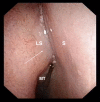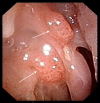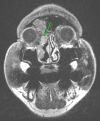Inverted Papilloma of the Lacrimal Sac and Nasolacrimal Duct: A Case Report and Review of the Literature
- PMID: 32201666
- PMCID: PMC7075512
- DOI: 10.7759/cureus.6989
Inverted Papilloma of the Lacrimal Sac and Nasolacrimal Duct: A Case Report and Review of the Literature
Abstract
Inverted papillomas of the lacrimal sac and nasolacrimal duct are exceedingly rare. Though histologically benign, these tumors are locally aggressive, have propensity for recurrence and are associated with a chance of malignant transformation. These tumors can present in an innocuous manner, masquerading as more common conditions such as primary acquired nasolacrimal duct obstruction. We present our experience with one such case and a review of the literature to emphasize the importance of pre-operative assessment and intra-operative vigilance, so as to aid in accurate diagnosis and early treatment.
Keywords: dacryocystorhinostomy; inverted papilloma; lacrimal sac; nasolacrimal duct.
Copyright © 2020, Cheang et al.
Conflict of interest statement
The authors have declared that no competing interests exist.
Figures







Similar articles
-
Inverted papilloma originating from the lacrimal sac and the nasolacrimal duct with marked FDG accumulation.Radiol Case Rep. 2021 Sep 20;16(11):3577-3580. doi: 10.1016/j.radcr.2021.08.039. eCollection 2021 Nov. Radiol Case Rep. 2021. PMID: 34584595 Free PMC article.
-
Sinonasal (Schneiderian) papilloma of the lacrimal sac.Proc (Bayl Univ Med Cent). 2019 Jan 16;32(1):121-123. doi: 10.1080/08998280.2018.1533357. eCollection 2019 Jan. Proc (Bayl Univ Med Cent). 2019. PMID: 30956605 Free PMC article.
-
Inverted papilloma of the nasolacrimal system invading the orbit.Ophthalmic Plast Reconstr Surg. 2007 Mar-Apr;23(2):151-3. doi: 10.1097/IOP.0b013e318032b5a6. Ophthalmic Plast Reconstr Surg. 2007. PMID: 17413635
-
Clinically suspected primary acquired nasolacrimal duct obstruction: clinicopathologic review of 150 patients.Ophthalmology. 1997 Nov;104(11):1882-6. doi: 10.1016/s0161-6420(97)30012-8. Ophthalmology. 1997. PMID: 9373121 Review.
-
Recurrent conjunctival papilloma causing nasolacrimal duct obstruction.Am J Ophthalmol. 1990 Jul 15;110(1):17-22. doi: 10.1016/s0002-9394(14)76931-4. Am J Ophthalmol. 1990. PMID: 2195893 Review.
Cited by
-
A case report of exophytic nasal papilloma with acute dacryocystitis as the first symptom.BMC Ophthalmol. 2021 Dec 29;21(1):458. doi: 10.1186/s12886-021-02223-8. BMC Ophthalmol. 2021. PMID: 34965868 Free PMC article.
-
Exclusive or combined endoscopic approach to tumours of the lower lacrimal pathway: review of the literature.Acta Otorhinolaryngol Ital. 2024 May;44(Suppl. 1):S67-S81. doi: 10.14639/0392-100X-suppl.1-44-2024-N2966. Acta Otorhinolaryngol Ital. 2024. PMID: 38745518 Free PMC article. Review.
-
Sphenoid Inverted Nasal Papilloma Presenting as Chronic Headaches in a 21-Year-Old Patient: A Case Report and Literature Review.Cureus. 2024 Jul 24;16(7):e65262. doi: 10.7759/cureus.65262. eCollection 2024 Jul. Cureus. 2024. PMID: 39184639 Free PMC article.
-
Inverted papilloma originating from the lacrimal sac and the nasolacrimal duct with marked FDG accumulation.Radiol Case Rep. 2021 Sep 20;16(11):3577-3580. doi: 10.1016/j.radcr.2021.08.039. eCollection 2021 Nov. Radiol Case Rep. 2021. PMID: 34584595 Free PMC article.
References
-
- Inverted papilloma of lacrimal sac invading into the orbit: case report and review of literature. Hardy AW, Dwivedi RC, Masterson L, et al. https://www.researchgate.net/publication/275052336_Inverted_papilloma_of.... J Cancer Res Ther. 2015;11:238–240. - PubMed
-
- Inverted papilloma of the nasal cavity and paranasal sinuses. Mendenhall WM, Hinerman RW, Malyapa RS, et al. Am J Clin Oncol. 2007;30:560–563. - PubMed
-
- Transitional neoplasms of the nasolacrimal system: a review of the histopathology and histogenesis. Heathcote GJ. https://www.researchgate.net/publication/255987698_Transitional_neoplasm... Saudi J Ophthamol. 2012;26:125–131. - PMC - PubMed
-
- Heindl LM, Jünemann AG, Kruse FE, Holbach LM. Orbit. Vol. 29. Holbach: Heindl LM1, Jünemann AG, Kruse FE; 2010. Tumors of the lacrimal drainage system; pp. 298–306. - PubMed
Publication types
LinkOut - more resources
Full Text Sources
